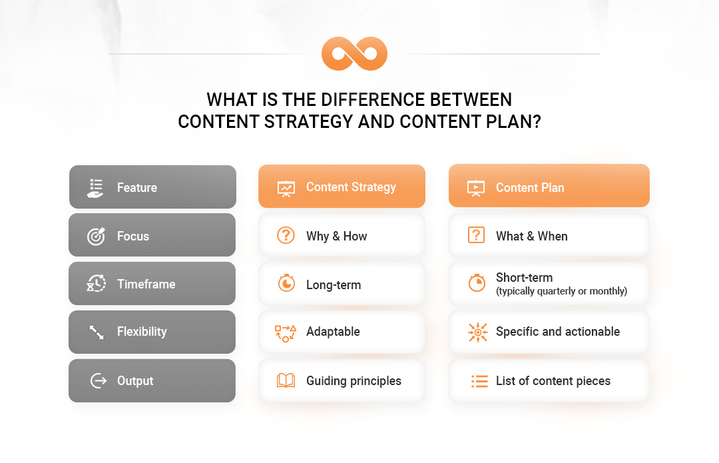Content Chaos vs. Content Conquest: The Battle for Attention
Forget about sword fights – the real battle online is for your audience's attention! Imagine millions of messages bombarding them daily, each fighting for a tiny slice of their attention. Simply throwing more content online is no longer an effective strategy. You need a strategic plan, like a roadmap. Instead of getting lost in the chaos, you'll conquer the content battlefield and reach your goals, but only if, and only if, you have a strategic content plan.
What is Content strategy?
Content strategy is a set of rules and principles that are the industry standard for managing future content on marketing channels where you can reach your audience to achieve predetermined goals.
But what if numbers speak louder than words?
For the data-driven decision maker, consider this: companies with an organized content strategy boast 54% more website traffic than those without one.
What does it mean to have a content strategy?
Without a content strategy, even the best products can struggle to find their audience. If we're going to be brutally honest, investing in creating a content strategy can make or break your business.
A properly created content strategy is a guarantee that your audience will be aware of the solution to the problem as well as the transformation path that your product brings to them.
A content strategy allows you to control the messaging you send to the public, maximizing its impact.
As Monadlead affiliates, understanding the power of content strategy is crucial to achieving peak campaign performance.
Why is content marketing strategy important?
Before diving into content creation, define your North Star: the specific goal your content strategy aims to achieve.
Imagine your ideal customer after experiencing the success your product offers.
What emotions and positive feelings do they have?
What problem have you solved for them?
Aligning your content with this desired outcome is key. Not surprisingly, research shows companies with successful content strategies boast over three times the average conversion rate.
In simpler terms, their content effectively leads customers towards their desired action.
But don't just set goals, track your progress! The right content strategy includes clear metrics to measure its effectiveness, ensuring you're on the right path to content marketing success.
The Cost of Content Anarchy: Time, Money, and Missed Opportunities
"Failing to plan is planning to fail - Alan Lakein
Anarchy in the content strategy can be a cancer of the wound and the cause of failure of all marketing efforts.
One of the main things that can appear as a side effect of anarchy in content strategy is not noticing new opportunities.
Just imagine your competitor who has a content strategy in place. One key advantage of having a content strategy is the ability to identify and capitalize on emerging opportunities.
When content marketing is in anarchy, there is no chance that anyone from marketing will notice the opportunity and use it to attract the target audience.
Anarchy in content strategy has two types of costs - active and passive.
Active costs caused by anarchy in content strategy represent the costs of your content team working without a strategy.
Passive costs that are caused by not having a content strategy are those costs that we can assume we have lost by missing opportunities that pass by without us noticing them.
A good content strategy is also a great opportunity to bring order to the finances of the content team and marketing.
In addition to these two important aspects that we have mentioned, the content strategy also gets the most out of your content team, and only in this way can each member give their best.
Content Marketing Strategy Examples
Content isn't just words on a screen; it's the lifeblood of your brand.
From engaging blog posts to informative videos, compelling content keeps your audience engaged, builds trust, and drives results.
But not all content is created equal. The key to reaching the top lies in crafting a strategic content plan tailored to your specific audience, product, and goals.
That's why we're excited to share several real-world examples of content strategies that have worked for us, offering valuable insights you can adapt to your brand journey.
Awareness content strategy
The goal of Awareness content is to increase brand visibility, reach a new audience, generate interest and curiosity, and round it all off with an increase in traffic to your website or other channels.
Content formats that support this type of strategy are Blog posts, Infographics, Social media content, explainer videos, podcasts or interviews.
For a better and more effective awareness content strategy, we need to base ourselves on high-value content targeting the right audience. That content should be optimized for search engines and promoted on different channels.
To know that it is successful, it needs to be monitored.
Targeted persona-centric content strategy
Creating a target persona, I won't lie to you, is a complex process. Beware of oversimplifications. Creating a target persona is a complex and lengthy process and requires time. Content created for target persons shifts the focus from the general and general audience to well-defined personas.
The key benefits of this type of content strategy are increased efficiency and stronger brand loyalty. It also enables you to make data-driven decisions for any form of automation.
Content formats intended for this type of content strategy are short concise videos, in-depth blog posts, webinars, educational content, customer testimonials, and case studies.
A small set of tips that can improve the performance of this type of strategy:
- Showing empathy
- Offer solutions
- Personalizing the experience
- Test and iterate
SEO content strategy
Don't be fooled by rumors of SEO's demise! It's alive and kicking, especially in the world of affiliate marketing.
When you weave SEO principles into your content strategy, you tap into the golden vein of informational searches, where potential customers actively seek solutions and comparisons before buying.
Think of it as a marathon, not a sprint – results take time, but they're sustainable and organic.
An SEO-optimized approach delivers several benefits: boosted organic traffic, improved brand visibility and authority, and a natural way to stay ahead of search behavior and trends.
The key lies in prioritizing user intent, and crafting content that satisfies their curiosity in a clear, concise, and engaging way.
This, coupled with strategic content structure and optimized visuals, fuels the success of your SEO-driven affiliate marketing efforts.
How to get ahead of your competitors with content strategy?
Staying ahead in the competitive landscape requires constant effort, and a well-defined content strategy is your roadmap to success. This plan ensures consistent, high-quality content that resonates with your audience and establishes your brand authority. But a winning strategy goes beyond just creating content. Keeping an eye on your competitors' strategies and formats – ethically, of course! – offers valuable insights into their strengths and weaknesses, helping you refine your own approach.
Understanding your audience is equally crucial. Analyzing their wishes, pain points, social media interactions, and direct feedback provides invaluable clues about what content resonates with them. By staying attuned to these insights, you can anticipate their needs and deliver solutions before they even know they need them.
But the game doesn't stop there. True leadership lies in proactively shaping the future by identifying emerging industry trends and creating content that influences the conversation. While staying ahead can be challenging, it's achievable with dedication and a continuous learning mindset. Remember, authenticity takes time, but when you're passionate about your work, the results will speak for themselves.
To ensure your competitors remain in your rearview mirror, never stop learning, embrace new trends, and stay deeply connected to your audience. This winning combination will keep your brand at the forefront, consistently delivering value and attracting customers.
What is the difference between content strategy and content plan?
Ever feel like "content strategy" and "content plan" are interchangeable? While they share a common root, these terms represent distinct stages in your content journey. Think of your content strategy as the map leading to your desired destination – like building brand awareness or increasing sales. It identifies your target audience, defines your brand voice and identity, and charts the overall course.

On the other hand, your content plan is the actionable roadmap. It specifies the types of content you'll create, the publishing schedule, and the channels you'll use to bring your strategy to life.
In simpler terms, the content strategy answers the "why" and "how" – why are you creating content and how will you achieve your goals? Meanwhile, the content plan focuses on the "what" and "when", detailing the specific content formats you'll use and the exact timing of your publications.
How to Create a Content Marketing Strategy Template
Creating a content strategy is a process that requires an understanding of specific goals, audiences, and industries.
There is no universal template for creating a content strategy.
Instead, there are steps you need to go through to create your content strategy.
Steps for creating a content strategy:
- Understand your audience
- Conduct a Content Audit
- Choose a Content Format
- Make Editorial Calendar
- Optimize for SEO
- Measure and Adapt

Finally, a few additional tips for what a better plan implies is to focus on quality before quantity, by building connections with authorities and following trends.
Table of Content
Subscribe and follow









